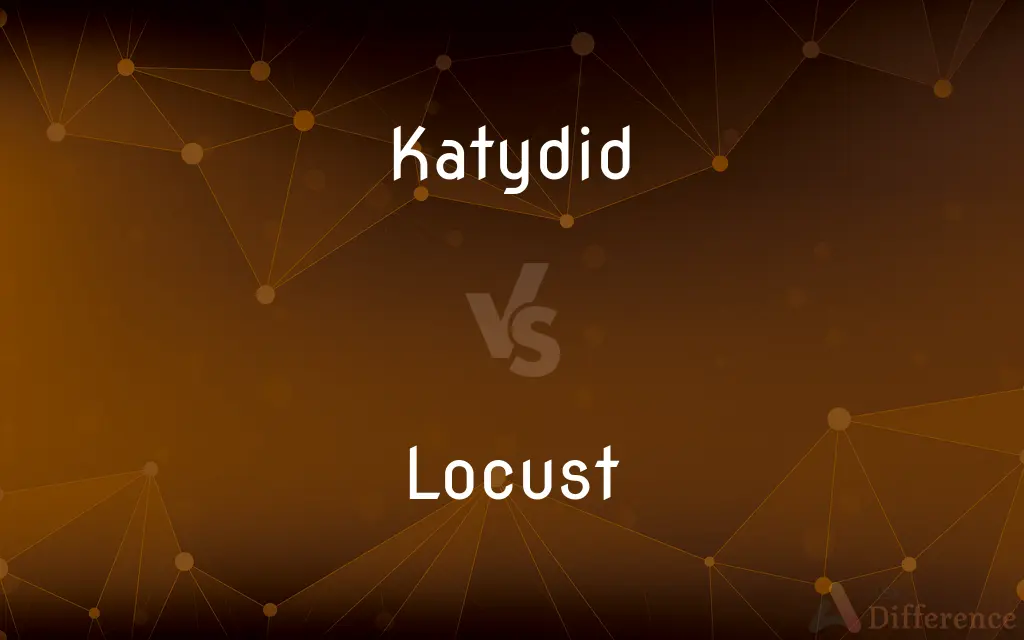Katydid vs. Locust — What's the Difference?
By Tayyaba Rehman & Fiza Rafique — Updated on March 29, 2024
Katydid is known for its leaf-like appearance and chirping songs, primarily nocturnal, while locusts are grasshopper-like, infamous for daytime swarming behavior.

Difference Between Katydid and Locust
Table of Contents
ADVERTISEMENT
Key Differences
Katydid, belonging to the family Tettigoniidae, mimics leaves for camouflage and is most active at night, producing distinctive sounds. On the other hand, locusts are a type of grasshopper, recognized by their ability to form large swarms that devastate crops, predominantly seen in daylight.
Katydid's diet mainly consists of leaves and flowers, showcasing their preference for a vegetarian diet, which subtly impacts local flora. Locusts, conversely, have a more aggressive approach to feeding, consuming vast amounts of vegetation quickly, leading to significant agricultural damage.
The mating call of a katydid is a unique chirping sound, vital for attracting mates in the nocturnal silence. Locusts, while also capable of producing sounds, are more notorious for the noise created by their swarming activity rather than individual calls.
Katydids are solitary creatures, with interactions largely limited to mating. This contrasts sharply with locusts, which are known for their gregarious phase, transforming from solitary to highly social beings, leading to the formation of large swarms.
The lifecycle of a katydid involves undergoing incomplete metamorphosis, which means they develop through stages from nymph to adult without a drastic change in appearance. Locusts also undergo incomplete metamorphosis, but their behavior and social structure can dramatically change depending on environmental conditions, such as density and resource availability.
ADVERTISEMENT
Comparison Chart
Appearance
Leaf-like, green, and camouflaged
Grasshopper-like, often less camouflaged
Activity Time
Primarily nocturnal
Primarily diurnal
Diet
Leaves and flowers
Various plants, causing agricultural damage
Social Behavior
Solitary, except during mating
Can be solitary or form massive swarms
Mating Calls
Chirping sounds for communication
Less known for individual sounds, noise comes from swarm movement
Metamorphosis
Incomplete, with gradual development
Incomplete, with environmental cues triggering swarming behavior
Compare with Definitions
Katydid
Undergoes incomplete metamorphosis.
The katydid nymph grows larger with each molt, gradually taking on adult features.
Locust
A type of grasshopper known for forming swarms.
The locust swarm darkened the sky as it moved through the farmland.
Katydid
Primarily vegetarian, feeding on leaves and flowers.
This katydid was seen munching on a rose petal.
Locust
Undergoes incomplete metamorphosis with behavioral changes.
The locust nymphs began to gather, signaling the start of a swarm.
Katydid
A nocturnal insect resembling a leaf for camouflage.
The katydid blended so well among the leaves, it was almost invisible.
Locust
Causes significant agricultural damage.
Farmers are bracing for the locust outbreak to protect their crops.
Katydid
Known for its distinctive chirping sounds at night.
The sound of katydids filled the summer night air.
Locust
Can switch between solitary and gregarious behavior.
The previously solitary locusts are now forming a large, devastating swarm.
Katydid
Solitary by nature, except in mating season.
The solitary katydid emerges at night to feed and sing.
Locust
Active during the day, often in large groups.
Locusts swarmed the fields in broad daylight, consuming everything in sight.
Katydid
Any of various orthopteran insects of the family Tettigoniidae, having long antennae and usually a green body, the male of which produces a shrill sound by rubbing together specialized organs on the forewings.
Locust
Locusts (derived from the Vulgar Latin locusta, meaning grasshopper) are a group of certain species of short-horned grasshoppers in the family Acrididae that have a swarming phase. These insects are usually solitary, but under certain circumstances they become more abundant and change their behaviour and habits, becoming gregarious.
Katydid
A relative of grasshoppers and crickets, in the family Tettigoniidae.
Locust
Any of various short-horned grasshoppers that sometimes migrate in immense swarms, devouring vegetation and crops.
Katydid
A large, green, arboreal, orthopterous insect (Cyrtophyllus concavus) of the family Locustidæ, common in the United States. The males have stridulating organs at the bases of the front wings. During the summer and autumn, in the evening, the males make a peculiar, loud, shrill sound, resembling the combination Katy-did, whence the name.
Locust
A cicada, especially a periodical cicada.
Katydid
Large green long-horned grasshopper of North America; males produce shrill sounds by rubbing together special organs on the forewings
Locust
Any of several trees of the pea family bearing long pods, especially the black locust, honey locust, and carob.
Locust
The wood of any of these trees.
Locust
Any of the grasshoppers, often polyphenic and usually swarming, in the family Acrididae that are very destructive to crops and other vegetation, especially the migratory locust (Locusta migratoria).
Locust
A fruit or pod of the carob tree.
Locust
Any of various often leguminous trees and shrubs, especially of the genera Robinia and Gleditsia; the locust tree.
Locust
A cicada.
Locust
A Mainlander.
Locust
(intransitive) To come in a swarm.
Locust
Any one of numerous species of long-winged, migratory, orthopterous insects, of the family Acrididæ, allied to the grasshoppers; esp., (Edipoda migratoria, syn. Pachytylus migratoria, and Acridium perigrinum, of Southern Europe, Asia, and Africa. In the United States the related species with similar habits are usually called grasshoppers. See Grasshopper.
Locust
The locust tree. See Locust Tree (definition, note, and phrases).
Locust
Migratory grasshoppers of warm regions having short antennae
Locust
Hardwood from any of various locust trees
Locust
Any of various hard-wooded trees of the family Leguminosae
Common Curiosities
Do katydids sing during the day?
Katydids are most active and sing primarily at night, unlike locusts, which are diurnal.
Can katydids cause agricultural damage like locusts?
Katydids primarily feed on leaves and flowers and generally do not cause significant agricultural damage compared to locust swarms.
Why do locusts form swarms?
Locusts form swarms in response to environmental conditions, such as high population density and scarcity of resources.
Are katydids solitary or social insects?
Katydids are solitary insects, interacting mainly for mating, unlike locusts, which can become highly social under certain conditions.
How do locusts affect farming?
Locusts can devastate crops by consuming vast amounts of vegetation, leading to significant agricultural damage.
What is the lifecycle of a katydid?
Katydids undergo incomplete metamorphosis, developing from nymph to elders without a dramatic change in form.
What makes a katydid different from a locust?
Katydids mimic leaves for camouflage and are nocturnal, while locusts can form destructive swarms and are active during the day.
How do katydids camouflage?
Katydids use their leaf-like appearance to blend in with their surroundings, making them hard to spot.
What do katydids eat?
Katydids eat leaves and flowers, showing a preference for a vegetarian diet.
Are all locusts harmful to crops?
Not all locusts cause damage, but certain species can form swarms that are incredibly destructive to agriculture.
Can locusts be solitary?
Yes, locusts can be solitary, but they have the unique ability to change to a gregarious phase and form swarms.
What triggers locust swarms to form?
Locust swarms form in response to environmental triggers such as drought, rainfall, and population density.
How do locusts communicate?
While individual locusts can make sounds, they are more known for the noise created by their swarming behavior.
What is the significance of the katydid's song?
The katydid's song is primarily used for mate attraction and communication among individuals.
Do katydids and locusts share the same habitat?
Katydids and locusts can share similar habitats but have different behaviors and environmental impacts.
Share Your Discovery

Previous Comparison
Mission vs. Mandate
Next Comparison
Xanthine vs. HypoxanthineAuthor Spotlight
Written by
Tayyaba RehmanTayyaba Rehman is a distinguished writer, currently serving as a primary contributor to askdifference.com. As a researcher in semantics and etymology, Tayyaba's passion for the complexity of languages and their distinctions has found a perfect home on the platform. Tayyaba delves into the intricacies of language, distinguishing between commonly confused words and phrases, thereby providing clarity for readers worldwide.
Co-written by
Fiza RafiqueFiza Rafique is a skilled content writer at AskDifference.com, where she meticulously refines and enhances written pieces. Drawing from her vast editorial expertise, Fiza ensures clarity, accuracy, and precision in every article. Passionate about language, she continually seeks to elevate the quality of content for readers worldwide.















































